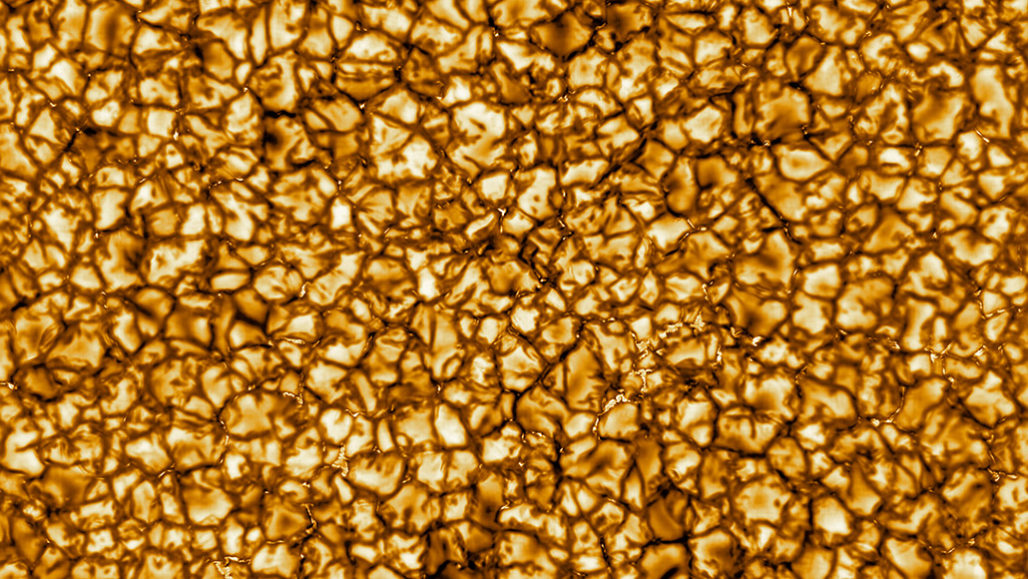See the sun in dazzling detail
Images from a newly opened telescope show boiling plasma on the star’s surface

Plasma bubbles boil on the sun’s surface. And bright spots between the bubbles mark the roots of the star’s magnetic fields. The stunning view comes from a new solar telescope’s first images. This image shows a region about 36,500 kilometers (22,680 miles) across.
NSO/NSF, AURA
Hot plasma churns on the sun in the newest and most detailed images ever taken of our star. These pictures come from the Daniel K. Inouye Solar Telescope on the Hawaiian island of Maui. It is named after a former senator from Hawaii who passed away in 2012. This instrument is still under construction. But that hasn’t stopped researchers from testing out this, the world’s largest solar telescope. And those tests showed it indeed works.
“We have now seen the smallest details on the largest object in the solar system,” said Thomas Rimmele. He is the director of the Inouye telescope. He described the new images January 24 during a teleconference. The first of those images were released January 29.
They reveal features on the sun’s surface just 30 kilometers (18.6 miles) across. That’s about just a third the size of anything that had been seen on the sun before.
The images cover an area 36,500 kilometers across. That’s roughly three times the diameter of Earth. They show familiar bubbles of plasma. Those bubbles are percolating up from deep below the surface. Dark lanes show up between the bubbles. They show newly resolved clusters of bright points. Those spots appear at the roots of magnetic fields that stretch out into space.
In fact, the telescope is being built to study magnetic structures on the sun. The goal is to learn more about the sun’s corona. That’s the sun’s outer atmosphere. It is millions of degrees hotter than the sun’s surface. A detailed look might lead to new insights into why that corona is so hot. It also could reveal what drives massive eruptions in the sun’s plasma. These eruptions can be so strong that they sometimes interfere with technology on Earth.
The new images are just a sneak peek at what’s to come. The new telescope is slated to officially start operating in July. Engineers are finishing the last tweaks to get it set up. This solar observatory is being built on a volcano that is called Haleakala. In Hawaiian, that name means “house of the sun.” And, when the telescope is complete, it promises to reveal features on the sun as small as 20 kilometers (12.4 miles).

Educators and Parents, Sign Up for The Cheat Sheet
Weekly updates to help you use Science News Explores in the learning environment
Thank you for signing up!
There was a problem signing you up.
At that point, astronomers will have three new sun-gazing instruments. This telescope will join NASA’s Parker Solar Probe. It is circling closer and closer to the sun. It is due to make its closest approach in 2024. The European Space Agency also has a new Solar Orbiter. It launched on February 9, 2019. If all goes as planned, it will journey to observe the sun’s poles.
Each instrument has a special role. Solar Orbiter will watch the sun from a unique vantage point — its north and south poles. Parker is snuggling up close. It will directly sample the plasma and the sun’s fields. And though it’s on Earth, Inouye should give astronomers unmatched details on the sun. That’s due to the telescope’s big 4 meter (13.1 foot) mirror. By being on the ground, it has another advantage, too. Researchers can easily adapt it to new questions that will inevitably arise.
Astronomers who study the sun are excited. Among them is Valentin Pillet. He directs the National Science Foundation’s National Solar Observatory. “It really is a great time to be a solar astronomer,” he says.







